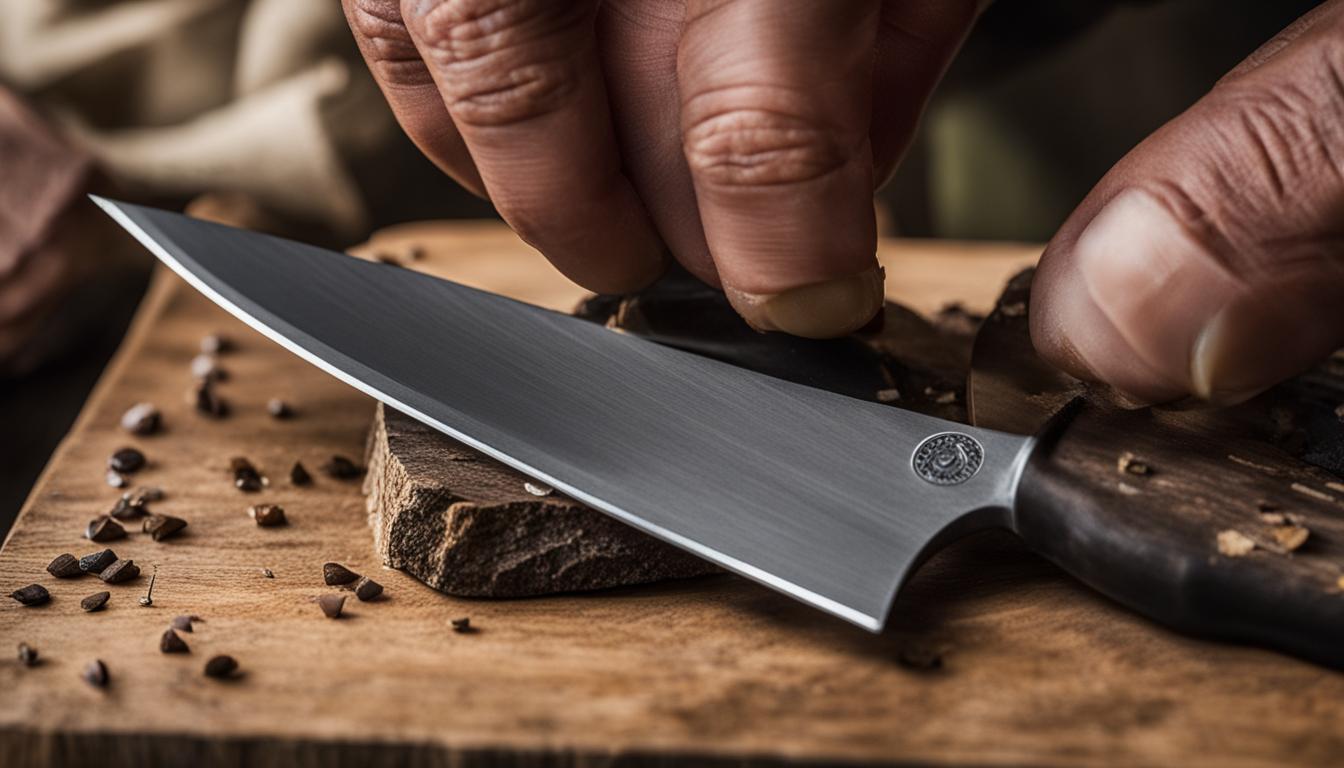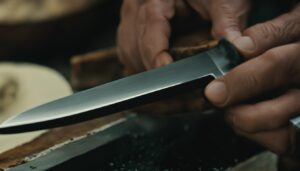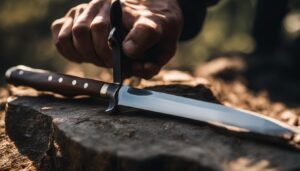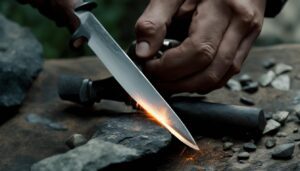Maintaining the sharpness of your hunting knife is essential for effective hunting and outdoor activities. In this ultimate guide, I will explore the different types of hunting knives and the corresponding sharpening techniques for each type. We will also discuss the various sharpening tools available, such as sharpening stones, honing rods, electric sharpeners, pull-through sharpeners, and guided sharpening systems. Additionally, I will provide step-by-step instructions on how to sharpen your hunting knife using a whetstone, as well as tips on how to keep your blade sharp for longer periods of time through proper care and maintenance.
Key Takeaways:
- Regularly sharpening your hunting knife is crucial for optimal performance in the field.
- Different types of hunting knives require specific sharpening techniques.
- There are various sharpening tools available, choose the one that suits your needs and skill level.
- Preparing your hunting knife properly before sharpening is essential.
- Sharpening a hunting knife using a whetstone requires a consistent angle and technique.
Types of Hunting Knives and Their Sharpening Techniques
When it comes to hunting knives, there are various types available, each with its own unique shape and purpose. It’s important to understand the different knife designs and the corresponding sharpening techniques to keep your blades in optimal condition. Here, I will discuss the sharpening techniques for drop point knives, clip point knives, gut hook knives, Bowie knives, and skinning knives.
Drop Point Knife Sharpening
A drop point knife is characterized by a slightly curved blade, with the spine of the blade dropping gradually towards the tip. To sharpen this type of knife, it is recommended to use a sharpening stone or honing rod with a rounded edge that can follow the curve of the blade. This allows for consistent and effective sharpening along the entire length of the blade.
Clip Point Knife Sharpening
The clip point knife features a straight edge with a clipped or concave portion near the tip, creating a distinctive shape. When sharpening a clip point knife, a straight-edged sharpening stone or honing rod is ideal. This allows for precise sharpening along the straight section of the blade, ensuring a sharp and efficient cutting edge.
Gut Hook Knife Sharpening
A gut hook knife is designed specifically for field dressing and opening the abdominal cavity of game animals. The gut hook is a small, curved blade located at the base of the main blade. When sharpening a gut hook knife, it is important to focus on sharpening the hook separately. This can be done using a small sharpening stone or rod, paying attention to the curved edge of the hook to maintain its effectiveness.
Bowie Knife Sharpening
The Bowie knife is a large, fixed-blade knife with a long and curved blade. When sharpening a Bowie knife, a longer sharpening stone or honing rod may be required to effectively cover the entire length of the blade. This ensures that the entire cutting edge is sharpened evenly, providing maximum cutting performance.
Skinning Knife Sharpening
A skinning knife is specifically designed for removing the skin from game animals. It typically has a narrow and curved blade, making it easier to control during the skinning process. To sharpen a skinning knife, a fine-grit sharpening stone or rod is recommended. This allows for precise sharpening, resulting in a razor-sharp edge that effortlessly glides through the skin.
By understanding the unique characteristics of each hunting knife type and the corresponding sharpening techniques, you can ensure that your blades remain sharp and ready for any hunting adventure.
Different Types of Sharpening Tools
In order to keep your hunting knife in optimal condition, it’s important to have the right tools for sharpening. Here, I will discuss the different types of sharpening tools available and their advantages and disadvantages.
Sharpening Stone
The sharpening stone, also known as a whetstone, is a classic tool used for sharpening hunting knives. It is available in various materials such as natural stone, diamond stone, ceramic stone, and synthetic stone. Each material has its own unique characteristics and level of abrasiveness. Sharpening stones allow for precise control over the sharpening process and can produce excellent results. However, they require some skill and practice to use effectively.
Honing Rod
A honing rod is used to straighten and maintain the edge of a blade between sharpenings. It is typically made of steel or ceramic and is designed to be used with a pulling motion. Honing rods are easy to use and can quickly restore the sharpness of a blade. They are particularly useful for touch-ups in the field. However, they are not as effective at removing significant dullness or damage.
Electric Sharpener
An electric sharpener is a convenient option for those who want quick and efficient sharpening. These sharpeners feature abrasive belts or discs that rotate to grind away metal and restore the blade’s sharpness. Electric sharpeners can be very effective and produce consistent results. However, they can remove a significant amount of material, so they should be used with caution to avoid over-sharpening or damaging the blade.
Pull-Through Sharpener
A pull-through sharpener is a portable and user-friendly option for sharpening hunting knives. It typically consists of two sharpening wheels with abrasive surfaces. To use a pull-through sharpener, you simply draw the blade through the wheels, applying light pressure. These sharpeners are easy to use and can produce satisfactory results. However, they can remove more metal than necessary if not used properly, potentially shortening the lifespan of the blade.
Guided Sharpening System
A guided sharpening system is a tool that helps maintain a consistent sharpening angle throughout the sharpening process. It typically consists of a base that holds the knife at a fixed angle and a sharpening stone or other abrasive medium. Guided sharpening systems provide excellent control and ensure that the blade is sharpened evenly. However, they may require more time and effort to set up compared to other sharpening tools.
Choosing the right sharpening tool depends on your skill level, the condition of your hunting knife, and your personal preferences. It’s important to use the tool correctly and follow the manufacturer’s instructions for optimal results. Additionally, regular maintenance and proper storage of your hunting knife will help preserve its sharpness for longer periods of time.
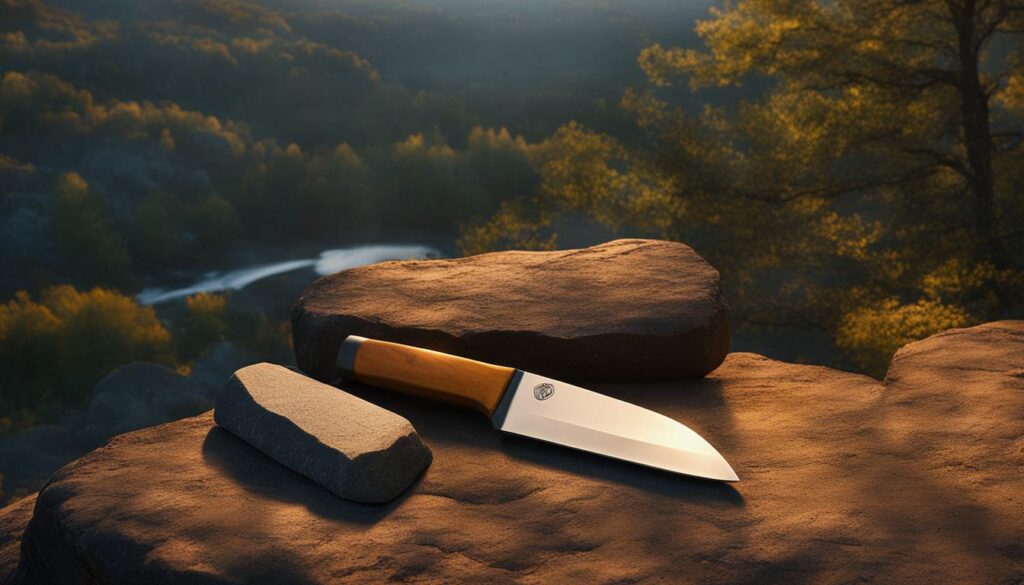
Preparing Your Hunting Knife For Sharpening
Before you begin sharpening your hunting knife, it is important to properly prepare it to ensure the best results. Follow these steps to get your knife ready for sharpening:
- Clean the blade: Start by cleaning the blade thoroughly to remove any dirt, debris, or residue. This can be done by wiping it down with a clean cloth or using a mild detergent and water if needed. Ensure that the blade is dry before moving on to the next step.
- Check for nicks and chips: Carefully inspect the blade for any nicks, chips, or damage. These imperfections can affect the sharpening process and the overall performance of the knife. If you notice any nicks or chips, use a file to smooth them out before proceeding.
- Determine the sharpening angle: The sharpening angle is crucial for achieving a sharp edge. Consult the manufacturer’s recommendations or use a sharpening guide to determine the correct angle for your specific knife. This will ensure that you maintain the original bevel and achieve the desired sharpness.
- Choose a sharpening method: There are various sharpening methods available, such as using a sharpening stone, honing rod, or electric sharpener. Consider your skill level and the type of knife you have when choosing the best method for sharpening. Each method has its own advantages and may yield different results.
By following these preparatory steps, you can ensure that your hunting knife is ready for sharpening, resulting in a razor-sharp blade that is ready for your next outdoor adventure.
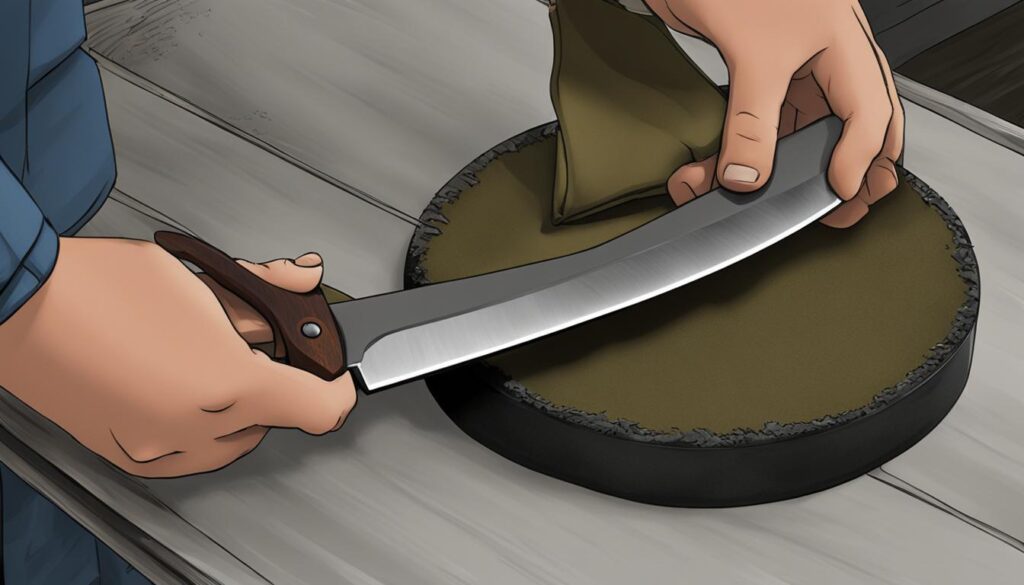

Frequently Asked Questions:
Q: Can I use soap and water to clean my hunting knife?
A: Yes, you can use a mild detergent and water to clean the blade. Just make sure to dry it thoroughly before proceeding with the sharpening process.
Q: How often should I check for nicks and chips on my hunting knife?
A: It is a good practice to regularly inspect your knife for any nicks and chips, especially before each sharpening session. This will help ensure that your blade is in optimal condition and ready for use.
Q: What is the recommended sharpening angle for hunting knives?
A: The recommended sharpening angle can vary depending on the type of knife and its intended use. It is best to consult the manufacturer’s guidelines or use a sharpening guide specific to your knife to determine the correct angle.
| Step | Description |
|---|---|
| Clean the blade | Remove any dirt, debris, or residue from the blade using a clean cloth or mild detergent and water. |
| Check for nicks and chips | Inspect the blade for any nicks, chips, or damage. Smooth out any imperfections with a file if necessary. |
| Determine the sharpening angle | Consult the manufacturer’s recommendations or use a sharpening guide to determine the correct angle for your knife. |
| Choose a sharpening method | Select the appropriate sharpening method based on your skill level and the type of knife you have. |
How To Sharpen A Hunting Knife Using A Whetstone
Sharpening a hunting knife using a whetstone is a time-honored technique that requires skill and precision. The key to successful sharpening lies in maintaining a consistent sharpening angle throughout the process. Here is a step-by-step guide on how to sharpen your hunting knife using a whetstone:
- Choose the right sharpening angle: The first step is to determine the correct sharpening angle for your knife. This can be done by referring to the manufacturer’s recommendations or using a sharpening guide. Once you have determined the angle, you can proceed to the next step.
- Prepare the whetstone: Place the whetstone securely on a flat surface and ensure it is clean and free from any debris. You may need to soak the stone in water for a few minutes before using it, depending on the type of whetstone you have.
- Sharpening process: Hold the knife securely and place the blade against the whetstone at the desired sharpening angle. Apply light pressure and move the blade back and forth along the stone in a sweeping motion. Be sure to maintain a consistent angle throughout the process. Repeat this motion on both sides of the blade, starting at the base and working towards the tip.
- Test the sharpness: After several passes on each side of the blade, you can test the sharpness by carefully running your finger along the edge. Be cautious and use light pressure to avoid any injuries. If the blade feels sharp and cuts through paper or fabric with ease, you can proceed to the next step.
Finish with a honing rod: To remove any remaining burrs and polish the edge of the blade, use a honing rod. Gently run the rod along the edge of the blade, moving from the base to the tip. This will help refine the edge and leave it razor sharp.
Remember, sharpening a hunting knife using a whetstone requires practice and patience. It is important to maintain a consistent angle and take your time to achieve the desired sharpness. With proper technique and regular maintenance, you can keep your hunting knife in optimal condition for all your outdoor adventures.
How To Keep Your Hunting Knife Sharp For Longer Periods of Time
Proper maintenance and care are essential for keeping your hunting knife sharp and in optimal condition for extended periods of time. By following these tips, you can ensure the longevity and performance of your blade.
Using a Honing Rod
One effective way to maintain the sharpness of your hunting knife is to regularly use a honing rod. A honing rod helps realign the blade’s edge and removes any burrs or imperfections that may have developed over time. Simply run the honing rod along the edge of the blade in a controlled manner, applying light pressure. This simple practice will help keep your hunting knife sharp between sharpenings.
Proper Knife Storage
The way you store your hunting knife can significantly impact its longevity. Always store your knife in a dry place to prevent moisture buildup, which can lead to rust and corrosion. Consider using a storage sheath or knife roll to protect the blade from accidental damage and maintain its sharpness. Avoid storing your knife in extreme temperatures or environments that may expose it to excessive heat or humidity.
Avoiding Misuse of the Knife
Using your hunting knife for tasks it is not intended for can quickly dull the blade and compromise its performance. Avoid using your knife as a pry tool, screwdriver, or any other non-cutting function. Additionally, be cautious when cutting through hard materials or bone, as this can cause the edge to chip or become damaged. Always use your knife for its intended purpose to minimize the risk of dulling or damaging the blade.
Regular Sharpening
Maintaining a regular sharpening routine is vital for keeping your hunting knife razor-sharp. Depending on how often you use your knife, you may need to sharpen it every few months or more frequently. Choose the sharpening method that works best for you, whether it’s using a sharpening stone, an electric sharpener, or another preferred tool. By committing to regular sharpening, you can ensure that your hunting knife remains in peak condition and ready for any outdoor adventure.
Conclusion
In conclusion, DIY hunting knife sharpening is an essential skill for any hunter looking to maintain the performance of their blades. By sharpening knives at home, hunters can ensure that their hunting blades stay razor sharp and ready for the field.
Maintaining sharpness requires regular maintenance and proper care. By following the techniques and tips outlined in this guide, hunters can effectively sharpen their knives and extend their lifespan. The use of different sharpening tools, such as sharpening stones, honing rods, electric sharpeners, pull-through sharpeners, and guided sharpening systems, provides flexibility and options for personal preference and skill level.
With a little practice and patience, hunters can develop their sharpening skills and keep their hunting knives in peak condition. By prioritizing safety, using caution during the sharpening process, and following proper knife storage practices, hunters can ensure optimal performance and longevity of their self-sharpening hunting blades.
FAQ
What is the importance of maintaining the sharpness of a hunting knife?
Maintaining the sharpness of your hunting knife is essential for effective hunting and outdoor activities.
What are the different types of hunting knives and their corresponding sharpening techniques?
Hunting knives include drop point, clip point, gut hook, Bowie, and skinning knives, each requiring specific sharpening techniques.
What tools are available for sharpening hunting knives?
There are various sharpening tools such as sharpening stones, honing rods, electric sharpeners, pull-through sharpeners, and guided sharpening systems.
How do I prepare my hunting knife for sharpening?
Before sharpening, clean the blade, check for any damage, determine the sharpening angle, and choose the appropriate method.
How do I sharpen a hunting knife using a whetstone?
Hold the stone securely, place the blade against the stone, apply light pressure, and move the blade back and forth at a consistent angle.
How can I keep my hunting knife sharp for longer periods of time?
Use a honing rod, store the knife properly, avoid misuse, and regularly sharpen the blade.
Can I sharpen my hunting knife at home?
Yes, this guide provides instructions on how to sharpen your hunting knife at home using various techniques and tools.
